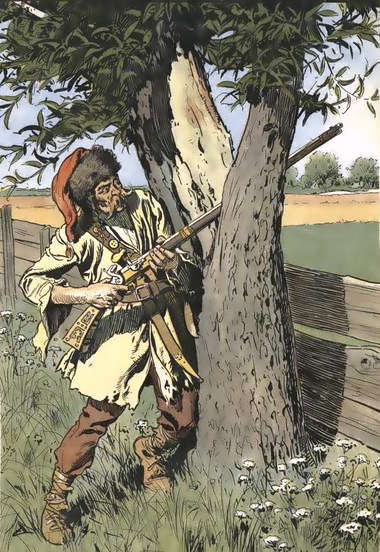The Pandurs (Croatian: Panduri, German: Panduren, French pandour) were a skirmisher unit of the Habsburg Monarchy.
The term pandur made its way into military use via the Hungarian language-being used in Hungarian as a loanword, in turn originating from the Croatian term pudar, though the nasal in place of the “u” suggests a borrowing before Croatian innovated its own reflex for Proto-Slavic. “Pudar” is still applied to security guards protecting crops in vineyards and fields, and it was coined from the verb puditi (also spelled pudati) meaning to chase or scare away. The meaning of the Hungarian loanword was expanded to guards in general, including law enforcement officers. The word was likely ultimately derived from medieval Latin banderius or bannerius, meaning either a guardian of fields or summoner, or follower of a banner.
By the middle of the 18th century, law enforcement in the counties of Croatia included county pandurs or hussars who patrolled roads and pursued criminals. In 1740, the term was applied to frontier guard duty infantry deployed in the Croatian Military Frontier (Banal Frontier), specifically its Karlovac and Varazdin Generalcies. The role of the pandurs as security guards was extended to Dalmatia after the establishment of Austrian rule there in the early 19th century
They were truly “national” or “local” regiments, raised under Hungarian administration and charged with the defense of the Imperial borders against the Infidel. They were alternately known as Grenzers, Pandours and Croats (six of the regiments were, indeed, Croatian; the others were Slovenian, Serb and Wallachian), and were all but identical to their Bosnian and Albanian counterparts who served as Sekhans/militias in the Ottoman armies of the time. Sometimes, companies or “bands” of Grenzers would be required by the main Imperial armies, in which they would be grouped into battalions and ad hoc brigades for organizational purposes.
The Grenze were masters of the Kliene Krieg, having been engaged in it “informally” for hundreds of years, fighting against the Turks as well as each other.
The Croat, Pandour, and Grenzer light infantry of the Habsburg army was reputedly the best in Europe, and played a particularly important role during the War of the Austrian Succession. In 1756 they comprised almost a quarter of the Austrian army. By 1808 it contained 62 light infantry battalions.
Among the minor units the Napoleonic French acquired in eastern territories were the Pandours, a combination of militia and gendarmerie dating from the old Turkish wars of two and three hundred years before. They drew no pay, but in peace they and their animals were exempt from all corvees (forced labor service); in war they had plunder rights. All members had to meet certain standards of drill and marksmanship. Normal duties were the patrol of the vague and unquiet borders of the Turkish provinces; the escort of couriers and supply trains; the enforcement of sanitary regulations; and the protection of travelers and merchants. The French began organizing such units-known variously as Pandours Dalmates, Pandours Albanias, Pandours Illyrians, or Pandours Ragusans-shortly after they arrived in 1808. In 1810 those formations were combined into the Regiment des Pandours Albanias. The Serezaners, or Pandours Croates, of Illyria, which the French took over in 1809, had similar functions. All of them, and emphatically the Serezaners, were accused of believing that travelers were safer when not carrying money and valuable property, and to have made certain that they didn’t, whenever such compassionate measures could be taken discreetly.”‘
